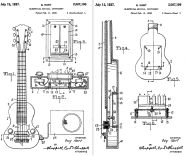
Guy Hart, general manager of the Gibson guitar company, gets the first patent for an electric guitar pickup. Gibson’s is not the first electric guitar to market, but its pickup design is superior to competing models’.
The first viable electric guitar was designed by guitarist George Beauchamp to boost the instrument’s volume over the drums, brass, and audience chatter. He began manufacturing them with engineer Adolph Rickenbacker (see here). Their guitars were “lap steel”: the player held the instrument flat in his lap and slid a metal bar up and down the strings. All guitar pickups employ essentially the same design: one or more magnets wrapped in a thin coil of wire. Beauchamp’s pickup used two horseshoe-shaped magnets over the strings.

Guy Hart saw the market for lap-steel guitars growing and decided it was time Gibson got in the game. Hart and Gibson’s in-house engineers developed a new design: a fat steel blade positioned vertically underneath the strings. The blade was then sandwiched by two heavy magnets at the bottom, and the wire was coiled around the blade, above the magnets.
Gibson rolled out the E-150, its first electric, Hawaiian-style lap-steel guitar, in 1935. It came with an amplifier (like all electric guitars then), and the whole package sold for $150 (about $2,500 in today’s leaf). Unlike Rickenbacker’s “frying pan” design, Gibson’s guitar actually looked like a guitar, complete with round feminine curves, shoulders, and scooped waist. Hart’s next design won the patent race: not a traditional hollow-bodied guitar getting a boost from a pickup, but rather a guitar that makes noise only when it’s plugged in.
As Hart predicted, the future wasn’t in acoustic boxes that got louder with the help of his device. He knew the secret: If you really want to rock, you’ve got to plug in!—MC